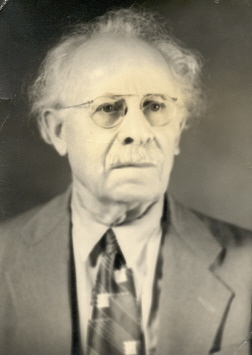Dr. Jacob Raphaelson's Story

The insightful and motivated optometrist or ophthalmologist could introduce a practical and effective method of solution for myopia prevention.
Dr. Jacob Raphaelson( see the picture )did exactly that in the following example—with the following results:THE PRINTER’S SON
" It was the year 1904 that I met a mother at a social lodge meeting. She told me about her son’s trouble with his eyes in school. I gave her my card and told her to bring him to my office and I would fit him with a pair of spectacles."
" She said she had no money at the time and that her husband was a printer working in another city. She did not expect him home for the next six weeks. I told her all this would not matter, that she should bring the boy over and I would fit him with a pair of spectacles. I told her that she could pay for them when her husband returned home."
" She brought the boy in and I examined his eyes. I found that his vision for distance was poor. It was less than 20/40. I made him a pair of +1.00 D spectacles. She was to pay me when her husband came back home."
" In about six weeks she came and returned the glasses to me. She stated that her husband was provoked with her for getting the glasses. He had tried the boy’s eyes with different prints, far and near, and had found him to have perfect vision with his naked eyes. In fact, she said, the boy could see even better without the glasses than with them."
" I was surprised that the plus lenses could produce recovery that quickly. I
could hardly believe this story. I persuaded the mother to bring the boy back to
let me check to see if he could really see well with his naked eyes. She again
brought the boy in and I checked his vision. I found that the father was indeed
right. The boy had good eyes, with 20/20 vision and better."
" I was in dilemma. I did not have the nerve to say anything to the mother. I
just let her go. How was I to prove that the boy had had poor vision before he
received his glasses? And who would believe that vision could be restored by
just wearing a pair of +1.00 glasses for a few weeks?"
" My experience with the printer’s son aroused my inborn tendency for exploration. It gave me an incentive to try to do special work on children’s eyes and on vision restoration. It also enticed me to investigate myopic (nearsighted) eyes because I was myself nearsighted."
" On the other hand, this experience was a warning to be cautious in doing such work. For selling spectacles to persons who, supposedely, did not need them was almost a crime. And the fitting of glasses without the advice or a consent of a medical doctor to unhealthy or diseased eyes, or even to an unhealthy person who might need or be under medical attention, was , and is now, an encroachment on the medical profession."
" To shield myself against possible enmity and involvement, I took the following precautions: First , I quit using the title ‘doctor’ in any form, in print or verbally. I was to be known as a spectacle fitter and nothing more. Second, I charged a reasonable price for the spectacles I sold but nothing extra for any special work or relief I gave. I did not advertise about this special work. I just did it as a matter of routine whenever or wherever I was given the opportunity."
" Thus in 1904 I became an independent researcher on the relation of the eye’s behavior to spectacles, vision, and health. I have kept it up, and will continue to do this work as long as I continue to have the incentive and capability."
" Who would believe it? Who would believe that by just wearing a pair of +1.00
glasses for a few weeks, that normal vision to the naked eye could be restored
to children whose eye’s have a negative refractive state? This was true in 1904,
and it is also true now, in this decade of 1950